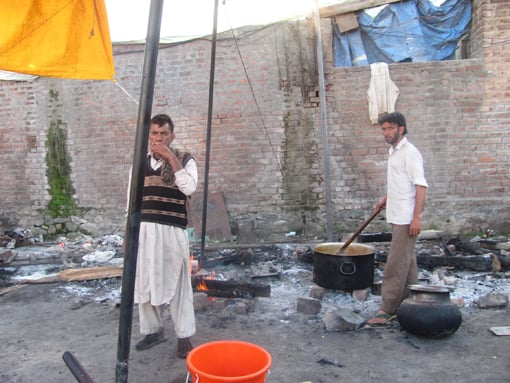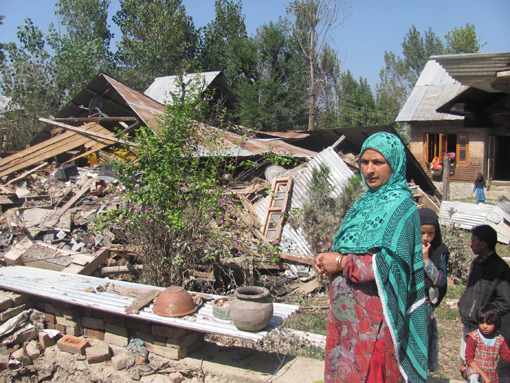One of the significant measures needed to avoid Kashmir’s recurring flood problems is delaying the water flow peak from river Jhelum’s four major tributaries by constructing flood storage basins in the catchment of Jhelum in south Kashmir and a comprehensive afforestation programme.
It has been suggested by flood Experts in Kashmir adding that such a floodwater storage project would be in line with the provisions of Indus Water Treaty (IWT) between India and Pakistan.
Following the devastating floods last September and the threat of another serious flood in late March, these experts want the Jammu and Kashmir government to immediately come up with feasibility studies for these flood storage basins and the already proposed project of building an 82-km long additional flood spill channel with a capacity of carrying 60,000 cusec (cubic feet per second) of water.
“One of the very basic flood-control measures will be the storage of flood water in large reservoirs in the catchment area only to release it when the flood threat subsides,” Zahoor Ahmad Chatt, a former chief engineer in the flood control department, told thethirdpole.net.
Chatt said that this would not violate the Indus Water Treaty since it has a provision for storing flood water of tributaries of the main river (Jhelum), if it is released back into the river immediately after the flood threat is over.
He said creation of storage basins is significant as the main tributaries of the Jhelum – Lidder, Romshi , Veshu and Rembiara – join the Jhelum in south Kashmir at almost the same place. “These tributaries share the same catchment and the peaks from all three reach at the same time thereby creating a flood situation whenever incessant rains occur.”
“So, regulating or delaying these peaks with the help of small reservoirs and allowing them to pass as per the capacity is the very basic flood control option available to us. It would be like regulating the traffic at a busy junction.”
He said that a comprehensive afforestation programme will also contribute significantly to a flood control programme. One of the fundamental principles in water management, Chatt said, is “arrest the water where it falls; make the running water walk and the walking water sleep.” He said that this can be achieved by a scientifically designed afforestation programme in Jhelum’s catchment.
“Afforestation will not only help in flood control, but will also arrest soil erosion which has been a huge cause of rapid siltation of our water bodies,” Chatt said.

Another former chief engineer of the flood control department, Syed Raza Shah Madani, also highlighted the need to create storage basins. “This is the ideal way of controlling floods. It works like a parking-slot for de-congesting the roads,” he said, adding it will not mean a breach of IWT given the provisions laid down by the treaty and the fact that there were flood basins and ponds along the Jhelum earlier. These have now been encroached upon.
“Almost the entire area on the left bank of Jhelum in Srinagar and most of the residential areas in up-town Srinagar used to be the flood basins in recent past,” Madani said. He suggested that massive catchment area treatment, following proper feasibility studies, should be carried out by creating ponds and mini lakes wherever possible in the catchment area.
Shakil Ahmad Romshoo, who heads the Earth Sciences department in Kashmir University, observed that strengthening flood control infrastructure in the watershed to delay the flood peak of these four high-gradient tributaries to the Jhelum in south Kashmir is crucial for any fool-proof flood control programme.
Making way for water
Kashmir’s flood control department officials say that they have started taking measures which include increasing the carrying capacity of the flood spill channel (FSC) and the Jhelum.
“The project for increasing the carrying capacity of Jhelum and FSC is part of the comprehensive flood control project for which we have got some interim funding and are expecting more in a few weeks from the central government,” said Kashmir’s Chief Engineer for Flood Control Javid Jaffer. “Approval for the entire project is pending till we submit the feasibility study of the additional flood channel.”
The project, which will enhance the carrying capacity of flood channels to 120,000 cusec, is estimated to cost Rs 21,083 crore ($3.4 billion). Of that, Rs 2,083 crore is for increasing the capacity of existing flood-control infrastructure and Rs 18,000 crore for creating the 82 km long supplementary flood control channel from Dogripora to the famous Wullar Lake, with a carrying capacity of 60,000 cusec.
As per a preliminary study, Rs 13,500 crore will go into compensating for over 2,200 acres of land and 2,400 structures including households and shops to build the additional FSC.
Independent experts agree that an alternate flood channel is mandatory, but want a detailed feasibility report. Madani says socio-economic aspects like dislocation of people and acquisition of agricultural land will have to be studied meticulously.
Romshoo is worried about the gradient issues. “The topography is such that we just have a 4-5 metre downhill angle available for this FSC. This means the water will not have a quick flow,” he pointed out.
The last flood control programme in Kashmir took place in the early 1900s with the construction of the 17,000-cusec capacity Srinagar-Wullar FSC and the dredging of the Jhelum.

